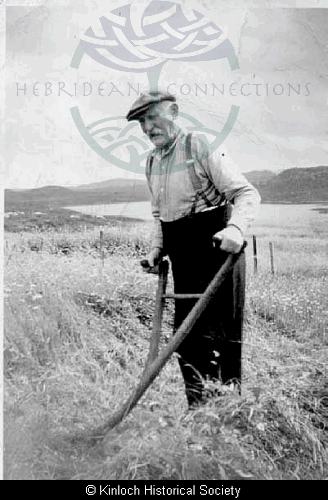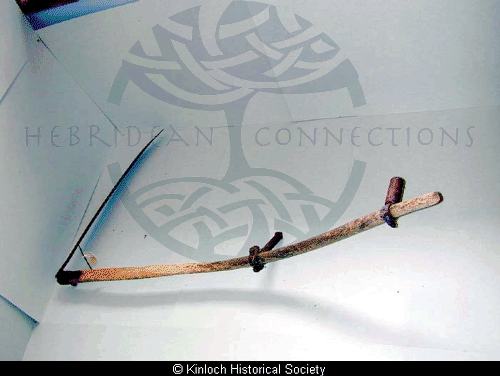39566: Cultivation of Crops
Busy days on the croft
Oats, barley and later potatoes were the main crops at first in Kinloch. The chief implements used were the crooked spade cas-chrom, the ordinary spade and the horse-drawn plough. Most of the arable land was turned into ‘lazy beds’ – a misnomer if ever there was one!
Taomadh, that is taking the soil from the ditches between the lazy-beds and laying it on top of them, was carried out both to assist drainage and to strengthen the soil. The lazy-beds were usually snake like in shape so that the crops, especially the corn, would not be easily flattened by the wind. Later on, if there was a sufficient area of flat land, the lazy-beds would be joined together so that the plough could be used. Stone drains were strategically laid in the fields so formed leòban and deep enough down so that the plough would not disturb them.
Another implement, the croman, a kind of hoe, was used to break up the soil pronnadh but sometimes a home-made harrow cliath would be dragged up and down the lazy-beds by someone with a towing rope tied round his/her chest. When larger fields came under cultivation, a heavier harrow was used but dragged by a horse. Sometimes a fairly heavy stone would be placed on the harrow to allow better penetration by the spikes if conditions demanded that. The spikes were usually made by the local blacksmith.
When the corn was ripe, it was sometimes cut with a sickle but usually with a scythe – barley was never cut, it was always plucked. When the corn was cut with the scythe, it would lie in swathes behind the reaper. Following behind him would be female members of the family and older children who would deftly tie the corn into sheaves sguaban. The sheaves were immediately stacked in a cone shape with the ears pointing upwards and the root ends on the ground with about ten sheaves to each cone adag. If the weather was good, the adagan would be carried in a few days to the stack yard iolainn, a dry-stone walled enclosure and there the corn stacks cruachan coirce would be built. If the weather was inclement, the adagan would be made into a smaller corn stack torran and when a good drying day came, the torran would be carried to the stack yard and the corn stack proper would be made. To secure the corn stack, a heather rope would be bound tightly round it. The top of the corn stack would be covered with a piece of canvas or sacking and tightly secured to prevent birds from stealing the grain.
The hay was stacked in the iolainn and there was also an art in making a haystack sìg so that the rain would run off them. Youngsters were encouraged to dance and prance on top of the haystack as it was being built in order to compress the hay and this was great fun. Before starting to build a sìg from the mounds gocan spread all over the hay fields, the local ‘meteorologist’ speuradair would be consulted and asked; "An dùil an dean e latha sìg? ("Do you think it will be a suitable day for making a haystack?")
Autumn was the most plenteous season of the year and Spring was the most scant. It was therefore often the custom to place a crock of salted butter in the middle of the haystack. This could not be retrieved until half the haystack had been consumed by the stock – usually at the beginning of Spring. What a bonanza to come across the salt butter in the lean times at the beginning of Spring.
Periodically, a corn stack would be taken into the barn and threshed. The hens got their share of the seed and to obtain this, the housewife would take a maide-frasaidh, a notched stick about a couple of feet long and with it she would strike the grain off the sheaves in front of the hens who would devour it rapaciously.
To thresh enough corn for the mill, a flail suist was used. This consisted of a handle lorg about five or six feet long, a swipple buailtean a couple of feet long, both attached to each other by a sheepskin thong or a strong piece of rope. To operate the flail required skill and concentration. It was swung over alternate shoulders, the swipple landing on the sheaves of corn laid out on the barn floor and separating the grain from them.
An improvement on the flail was the threshing mill. A small version, operated by two handles was common in Kinloch a century ago. Before the grain was ready for the mill it had to be winnowed and for this a riddle criathar was used. The criathar was circular, about two feet in diameter and four inches deep, pliable wood being used for the frame. The bottom was made of cured sheepskin and holes were made in the skin with a hot steel knitting needle. When the seed had been winnowed, it had to go to the kiln àth to have it dried and hardened. The kiln was usually about 25 feet in length and about 20 feet wide outside and the walls were about 3 feet thick.
Inside the door there was a fireplace (tealach) and from the fireplace a tunnel sòrn with a slight upward gradient, stretched up to the surrag which was an oblong vent covered with wood and straw over which the grain was placed to dry. At the surrag end of the tunnel, a slab of stone was placed vertically to extinguish any sparks that might be blown up through the tunnel. This stone slab was called clach-bhàthaidh. When the grain had been dried and hardened, it was ready to go to the mill Norse Mills for grinding.
The growing of vegetables was sometimes attempted but to be successful, one requisite was a high-walled enclosure which neither the hens nor the sheep could surmount. It became known as tobhta-chàil, the cabbage enclosure, probably because cabbage and kale were the main crops first planted. Turnips and carrots were soon popular and onions also. Insecticides were unknown but soot from the peat fires spread between the rows was very effective, especially against the carrot fly, and was also a useful fertiliser.
Article in Dioghlum magazine, 1997 by Jessina M Macdonald, Arivruach
Details
- Record Type:
- Story, Report or Tradition
- Type Of Story Report Tradition:
- Tradition
- Record Maintained by:
- CECL





